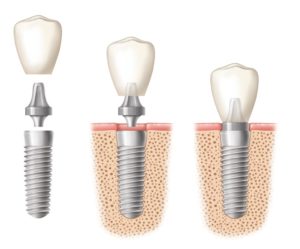 Dental implants are fast becoming the premier choice for tooth replacement, but of course, this doesn’t really help a patient if they can’t actually understand what their dentist is talking about. Discussing dental implants involves using a lot of terminology most people just aren’t familiar with. That’s why your dentist in Ponte Vedra Beach is happy to make this little guide to common dental implant terms. With it, you can easily stay well informed while rebuilding your smile.
Dental implants are fast becoming the premier choice for tooth replacement, but of course, this doesn’t really help a patient if they can’t actually understand what their dentist is talking about. Discussing dental implants involves using a lot of terminology most people just aren’t familiar with. That’s why your dentist in Ponte Vedra Beach is happy to make this little guide to common dental implant terms. With it, you can easily stay well informed while rebuilding your smile.
Abutment
This is a small metal connecter that is attached to a dental implant in order to support the replacement teeth above the gum line.
All-On-4
This is a procedure where a full denture is supported using only four dental implants. In many cases, the implants and the denture can actually be placed on the same day.
Arch
This refers to your top and bottom rows of teeth as well as the gum tissue and bone that supports them.
Bridge
This is a kind of dental restoration that can be used to replace multiple consecutive missing teeth. It works by placing two dental implants on either side of the gap in a person’s smile, and these are then attached to prosthetic teeth that fully close the space. You may also see this referred to as an “implant-supported bridge.”
Crown
This is placed on top of an implant in order to restore a single missing tooth. It is typically made out of porcelain and specially shaped to resemble a natural tooth in every way.
Dental Implant
This is a small titanium post that is placed directly into the jawbone in order to recreate the root structure of a lost tooth. One can be used to replace a single tooth or a few could be used to restore multiple teeth or an entire arch. Compared to other teeth replacements, implants provide a much more realistic recreation of the teeth and have been shown to last for 30 years or more.
Implant-Retained Denture
Also known as an “implant-supported denture,” this is a dental prosthetic used to replace multiple missing teeth that is fitted directly onto dental implants. Compared to a traditional removable denture, implant-retained dentures tend to be more comfortable, maintain their fit for much longer, and provide a patient with better speaking and chewing function.
Osseointegration
This is a process that occurs after the implants have been placed into the jawbone where they actually meld with the surrounding bone, creating an even more stable foundation for the replacement teeth.
Periodontal
This is a term that is used to refer to the structures surrounding the teeth, such as the gums and bone.
Placement Procedure
This is the minor surgery in which the implants are actually positioned within the jawbone. Using highly-detailed scans, your dentist or oral surgeon will choose the best location for the implant, make a small incision in your gums, and create a small hole in your jawbone to place the implant. A patient typically needs about 3-6 months to heal afterward before their new teeth can be placed. This procedure is virtually painless thanks to modern dental techniques and sedation.
Post
Another term that is used to refer to a dental implant, specifically the portion that is used to restore the root structure of a lost tooth.
Resorb
This is a term that is used to describe the bone degeneration that occurs after tooth loss. The body naturally starts resorbing nutrients from the jaw because it knows there are no teeth to support. As a result, the jaw shrinks, which can affect the alignment of the teeth as well as the overall appearance of the face.
Restoration
This is the part of the implant process where the replacement teeth are actually attached to the implants and may refer to a crown, bridge, or denture.
About the Author
Dr. Kristopher Harth is a general, cosmetic, and implant dentist based in Ponte Vedra Beach, FL. He believes that open and clear communication is essential to the doctor-patient relationship, and he’s always happy to take extra time to make sure his patients completely understand their dental care. If you have any questions about dental implants or are interested in getting them, he can be contacted through his website.



